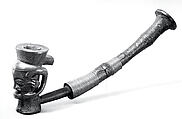Pipe: Head
Not on view
This elaborately carved and ornamented tobacco pipe was not merely a functional smoking implement, but was also emblematic of its owner’s status. The bowl of the pipe has been given the form of a head with exaggerated features accented by planes of smooth carving and textured incisions. The hair rises as a fluid mass from an angular hairline, sloping backwards. This directionality is mirrored by side tresses of hair that extend backwards into c-shaped loops that curve inwards to follow the jawline. At the summit of the coiffure is a circular hat or headdress whose front is decorated with an inverted trapezoid filled with a diagonal incised grid bounded by bands of parallel lines. This pattern also appears on the truncated conical neck and much of the back of the head. The headdress has a flat rectangular projection at the back, and a iron-lined circular hole at the top, where tobacco would have been placed. Additional bands of incised grids—representations of cicatrization patterns—appear on the cheeks, temples, and on the diagonal above the eyebrows. The bridge of the nose is straight and narrow, flanked on either side by inverted half-circle nostrils. The mouth is a projecting rectangle with rounded edges measuring the same width as the nose.
The wooden pipe stem was carved separately and attached at an angle via a hole in the lower back of the pipe bowl. The stem curves gently upwards into a fluted mouthpiece with a five-pointed metal star affixed to its flat end. Coiled copper wire wraps around the middle stem in two distinct bands flanking an indistinct carved motif. The wooden exterior of the metal-lined mouthpiece is carved with interlaced parallel bands. Such designs are reminiscent of those on embroidered Kuba raffia fiber prestige textiles. The wood of both the bowl and stem is an even medium brown with some darker brown in the deeper carved areas.
The origins of pipe smoking in West Central Africa have been debated; tobacco itself was likely introduced from the Americas by the Portuguese in the sixteenth century. (Philips 1983, 308, 317). By the time that European and American observers first visited the Kuba kingdom in the nineteenth century, tobacco smoking was a well-established social practice there. Established as a confederacy of chiefdoms by the seventeenth century, Kuba society is organized into eighteen distinct subgroups, each of which has an internal political hierarchy. Such extravagantly ornate pipes are attributes of this hierarchy’s most elite members. This work was commissioned during the unprecedented economic and artistic growth of the late nineteenth or earlier twentieth century Kuba kingdom. It closely resembles the figurative drinking vessels that Kuba elites—particularly men—used to drink palm wine (maan), a sweetly sour alcoholic beverage. Indeed, the thick projecting neck of the pipe bowl is nearly identical to the base used to support a typical palm wine vessel. Similarities in form and ornament between vessels and pipe bowls suggest that many were carved by the same artists (Binkley and Darish 2009, 28). Both the bowl of this pipe and a vessel in the Metropolitan’s collection (1978.412.541) share features that reflect distinctive Kuba styles: the exaggerated, elongated head and angular hairline were fashionable in the late nineteenth century, while the c-shaped tresses of hair refer to ram’s horns. Sheep were the royal prerogative of the nyim (the Kuba ruler) and his family, and thus were a rarified sign of status. As symbols of prestige, Kuba pipes were not stored out of sight when not in use, but rather worn tucked into their owner’s belt, visible for all to see.
Kristen Windmuller-Luna, 2016
Sylvan C. Coleman and Pam Coleman Memorial Fund Fellow in the Department of the Arts of Africa, Oceania, and the Americas
Further Reading
Binkley, David Aaron., and Patricia Darish. Kuba. Milan: 5 Continents, 2009.
Philips, John Edward. "African Smoking and Pipes." The Journal of African History 24, no. 03 (1983): 303-19.
Exhibition History
New York, Museum of Primitive Art, "The Clark and Frances Stillman Collection of Congolese Sculpture" (Exh. 40), 11/24/65–2/6/66, cat. no. 172 (loan no. 268.65)
New York, Bronx Museum of the Arts, "African Art from the Museum of Primitive Art," 6/28–7/28/72
Due to rights restrictions, this image cannot be enlarged, viewed at full screen, or downloaded.

